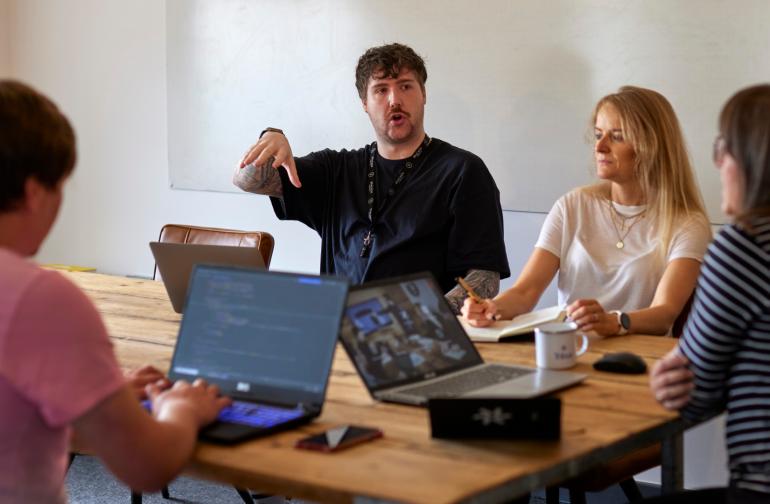In today’s fast-paced software development world, change management is no longer a luxury—it’s a necessity that too many software engineering teams and companies are still neglecting. As Antoine de Saint-Exupéry says:
“If you want to build a ship, don’t drum up the men to gather wood, divide the work, and give orders. Instead, teach them to yearn for the vast and endless sea.”
This sentiment rings true in our engineering world, where the need for proper change management is often overlooked.
Tribus does Leeds Digital
On a rainy Wednesday evening I attended the Software Engineering Leadership @ WRK - Meetup & Social - September 2024 where James Hall and Josh Nesbit recorded a live Q&A for their Off Script Podcast and shared their insights and facilitated a session based around ‘The future of software engineering leadership’.
Before the event, participants were asked to submit questions and there were some really great ones. But, the general theme of many of the conversations, be it soft skills, AI or sustainability was an undertone of a need for proper change management in the leadership. “How do you transition to in-office working?”, “How do you improve cohesion and collaboration in remote teams?” or “How do you rebuild team culture”. From my imperfect perspective, these kinds of issues are the perfect situations to model good leadership by making use of proper change management strategies.

Back to the office: The issue
One of the topical news stories that was highlighted during one of the responses was Amazon’s declaration that:
"We’ve decided that we’re going to return to being in the office the way we were before the onset of Covid," - Amazon's chief executive Andy Jassy
This has, quite rightly in my opinion, garnered a lot of negative press and even suggestions of indirect head count reduction techniques by some. But what seems to have happened in this case, as in many other instances in recent years, is a lack of proper change management to help the organisation transition into a new strategy.
There can be many reasons for this; An assumption that everyone else is already on the same page as the board, a misunderstanding or disregard of the wider impact that the change will make to the organisation. Even sometimes, there has been no planning or thought at all and the change is happening at the whim of a certain member or the leadership team.

Teach them to yearn for the vast and endless sea: The solution
As James and Josh mentioned in their Q&A, regarding retention and onboarding, our employees have so many options now. The world post COVID is a very different one, where new hires or interview candidates are more reluctant to interview in person and also reticent about completing interview tasks (even when they are paid). This means that one of the most important aspects of making a successful change in your organisation or team are your individuals. The people who are both affected by the change and are also going to effect the change. Prioritising them is vital in todays job market and the software industry we’re in.
There are lots of effective change management strategies out there:
McKinsey 7s model - identifies seven interdependent factors—Strategy, Structure, Systems, Shared Values, Skills, Style and Staff—that organisations must align to achieve successful change.
Kurt Lewin's Unfreeze-Change-Refreeze Model - emphasises the need for preparing individuals for change and ensuring the change becomes embedded in the organisation.
The Four Enablers of Change (McKinsey) - highlights four key enablers—Mindset Shifts, Leading with Purpose, Building Capabilities and Reinforcing with Mechanisms—that facilitate successful change in modern organisations. It emphasises the importance of a purpose-driven culture and individual empowerment.
More and more, the research is showing us that an effective change management model has a major emphasis on addressing the psychological and emotional aspects of change for employees. In practical terms this could look like involving employees in the decision-making process or conducting surveys.
This is reinforced by James Clear in his book Atomic Habits. The author emphasises that behaviour change often precedes culture change, suggesting that small, incremental changes in habits can lead to larger transformations over time. He argues that by focusing on improving individual habits and behaviours, people can gradually shift their identity, which in turn contributes to a cultural change within groups or organisations.
Change doesn’t just happen because we will it to or order it to. As software engineering leaders we must focus on the people, their environment and their emotions before we can expect change.

Call To Action!
So, the task is clear. As an industry we need to commit to taking our staff on the journey with us, developing the yearning for the place we’re going, instead of just ordering them to comply or expecting everyone else to just absorb our own passion for the destination. Take change seriously, read up on change management strategies and develop one which aligns closest with your own culture. Only then can change in your organisation be truly successful.









